Understanding Countyline Rototillers: A Comprehensive Guide
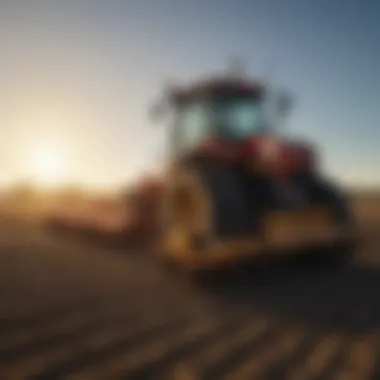
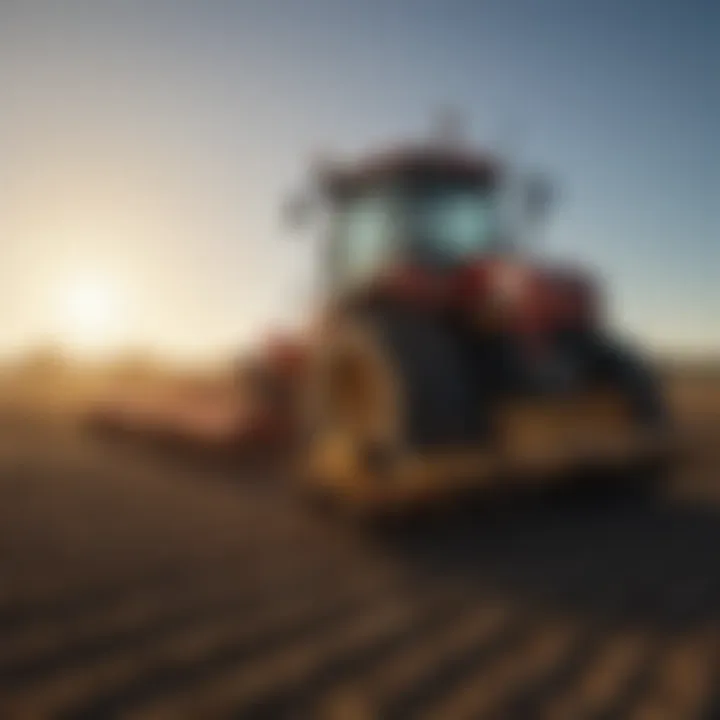
Intro
In modern agriculture, the role of machinery cannot be understated, particularly when it comes to soil preparation. Among various tools that farmers utilize, Countyline rototillers stand out for their design and functionality. These machines are critical for improving soil structure, mixing nutrients, and enhancing seedbed quality.
Overview of the Topic
Definition and Importance
Countyline rototillers are specialized equipment designed to prepare the soil for planting by breaking it up and aerating it. By turning over the soil, these tillers assist in incorporating organic matter, weed control, and the overall health of the soil ecosystem. The importance of well-aerated soil extends beyond aesthetics; it plays a direct role in crop yield and sustainability, making rototillers essential for modern farming practices.
Current Trends
In recent years, there has been a notable shift towards sustainable farming methods. Farmers increasingly rely on equipment that minimizes environmental impact while maximizing efficiency. Countyline has addressed this trend by integrating features that reduce fuel consumption and promote soil health. New models also focus on adapting to varying soil conditions, driven by advanced technology and engineering.
Key Techniques and Practices
Step-by-Step Guide
Using a Countyline rototiller effectively requires an understanding of several key techniques. Here’s a simplified process for preparing your soil:
- Assess Soil Condition: Before tilling, evaluate the moisture level and compactness of your soil. Ideal conditions are when the soil is moist but not overly wet.
- Select Appropriate Tiller Model: Choose a Countyline rototiller suited to your land size and intended use. Smaller units work well in gardens, while larger models are necessary for expansive agricultural areas.
- Set Desired Tilling Depth: Adjust the tiller according to the tilling depth needed; deeper tilling helps incorporate organic matter.
- Begin Tilling: Straight lines typically yield the best results. Overlap each pass slightly to ensure uniform coverage.
- Post-Tilling Assessment: After tilling, examine the soil texture. This helps determine if further work is needed.
Tools and Equipment Needed
To operate Countyline rototillers efficiently, the following tools are recommended:
- Protective Gear: Gloves, eye protection, and sturdy footwear are essential for safety.
- Tiller: A Countyline rototiller suited for your specific land needs.
- Soil Moisture Meter: To gauge the readiness of your soil.
- Rake: After tilling, a rake can help level the soil.
Challenges and Solutions
Common Obstacles
Despite the advantages of using Countyline rototillers, farmers face some challenges. Compacted soil can hinder the tilling process, making it difficult for machines to operate effectively. Weather conditions, especially excessive rain or dryness, can also impact soil quality.
Innovative Solutions
Farmers can mitigate such challenges through the following strategies:
- Soil Amendments: Applying organic matter before tilling can help break up compacted soil.
- Adaptive Equipment Use: Utilizing adjustable tillers allows for better adaptability to different soil conditions.
- Integrated Crop Management: Employing no-till farming practices in conjunction with tilling can improve long-term soil health.
Effective soil management is crucial for optimizing crop yields and maintaining ecological balance in farming practices.
This comprehensive guide aims to empower farmers and agricultural enthusiasts with knowledge about Countyline rototillers, making it easier to achieve sustainable farming goals.
Prelude to Countyline Rototillers
Countyline rototillers hold a significant place in modern agriculture. Their design and functionality make them invaluable for soil preparation. Farmers and gardening enthusiasts frequently use these machines to significantly improve soil aeration and seed bed quality. This section outlines the importance of Countyline rototillers in the agricultural context. It will explore the historical development of these tools and their well-established market position.
History and Development
The evolution of Countyline rototillers reflects a broader trend in agricultural equipment development. Initially, tilling relied on manual tools or basic machinery that necessitated much labor. The rise of motorized tillers began to reshape this landscape. Countyline has been a key player in this area, introducing more sophisticated models that provided greater efficiency and ease of use. Over the decades, enhancements such as adjustable tines and improved engine specifications advanced their performance. This historical progression illustrates how farmer needs prompted innovations, resulting in the robust models available today.
Market Position and Recognition
Today, Countyline rototillers are recognized as a reliable choice among professionals and hobbyists alike. The brand stands out for its durability and efficiency. Reviews from users often highlight the longevity and ease of maintenance of these machines. Furthermore, Countyline's reputation in the agricultural market is evidenced by a consistent demand for their products. Farmers appreciate their commitment to quality and innovation. Consequently, Countyline has established a respected position within the competitive agricultural equipment landscape, becoming synonymous with effective soil cultivation.
Types of Countyline Rototillers
Understanding the different types of Countyline rototillers is critical for anyone engaged in agricultural practices. Each type offers unique benefits and is tailored to specific gardening or farming needs. This section focuses on Rear Tine Rototillers, Front Tine Rototillers, and the comparison between Electric and Gas-Powered Models. By staying informed about these distinct categories, farmers can make educated decisions for better soil preparation and crop management.
Rear Tine Rototillers
Rear tine rototillers are often regarded as the more powerful option among the various types. They come equipped with tines that rotate backward. This allows for deeper tilling and better soil aeration. Rear tine models are typically more stable and can handle tough soil conditions. This makes them ideal for larger areas or for users who deal with compacted soil.
Some key benefits of rear tine rototillers include:
- Superior Tilling Depth: They can usually penetrate deeper into the soil compared to front tine models.
- Stability: These machines are designed to move more smoothly in rough ground conditions.
- Variety of Models: There are many models available for different kinds of agricultural tasks, making it easier to choose one that meets specific needs.
Front Tine Rototillers
Front tine rototillers have tines that rotate in the same direction as the wheels. This allows for excellent maneuverability in tighter spaces, making them a popular choice for gardeners with smaller plots. They are lighter and easier to control than rear tine models. However, they often struggle with tougher soil conditions, especially when it comes to compacted earth.
Here are some advantages to consider:
- User-Friendly: These machines typically require less physical effort to operate.
- Ideal for Smaller Spaces: Their design is more suitable for smaller gardens or raised beds.
- Cost-Effective: Generally, front tine rototillers are less expensive than their rear tine counterparts, which can be a significant factor for budget-conscious buyers.
Electric vs. Gas-Powered Models
The decision between electric and gas-powered rototillers can greatly affect usability and convenience. Each type has its own set of advantages and disadvantages.
Electric Models:
- Pros: These are quieter and require less maintenance. They are also easier to start and operate without the need for fuel handling. Great for home gardens and smaller tasks.
- Cons: Their power is limited and they may not handle tough conditions as effectively as gas models. They also require a power source, which can be limiting in remote areas.
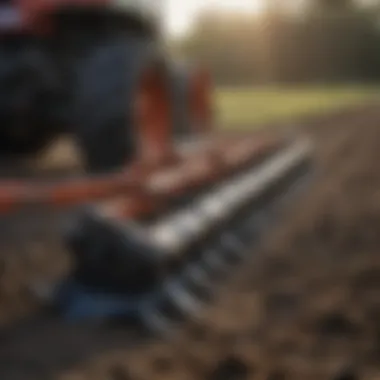
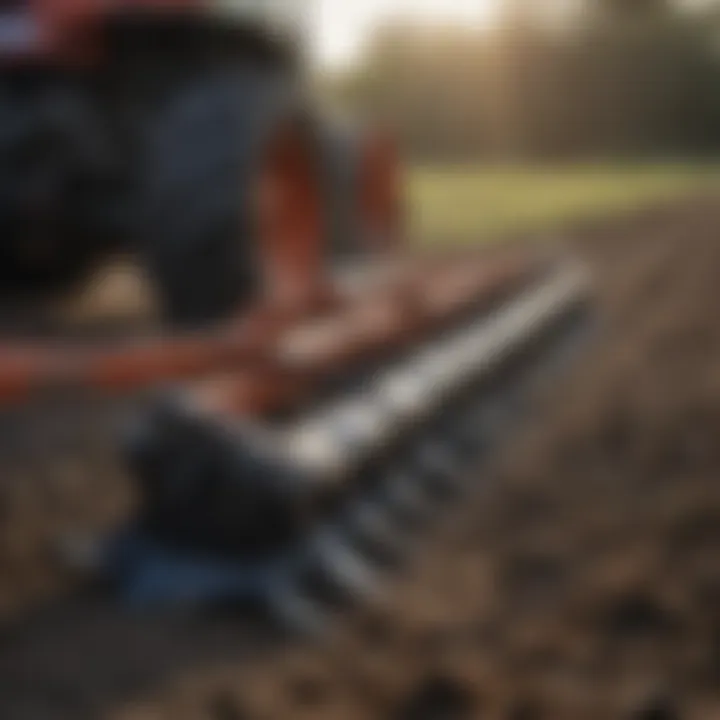
Gas Models:
- Pros: They offer greater power and are better suited for more heavy-duty tasks. Gas models are versatile and can work in larger spaces or tougher conditions without restrictions.
- Cons: These units tend to be heavier, noisier, and require more maintenance than electric options. They also create emissions, which can be a concern for environmentally conscious users.
Choosing between electric and gas ultimately depends on the tasks at hand and individual preferences regarding ease of use and power requirements. Evaluating the specific gardening or farming needs is essential for making this choice.
"The best rototiller for your needs will depend on your specific soil conditions and gardening goals."
Key Features of Countyline Rototillers
Understanding the key features of Countyline rototillers is essential for farmers and enthusiasts aiming for improved soil preparation. These features are not only integral to the machine's performance but also influence its adaptability to various farming conditions. Choosing the right rototiller can drastically affect the efficiency of your agricultural practices. Each of these elements enhances the equipment’s overall performance, durability, and efficiency.
Engine Specifications
The engine is the beating heart of any rototiller. Countyline rototillers typically feature robust engines that provide sufficient power to handle hard soil conditions. Standard engine types can vary, but they are often available in both gas and electric options. Gas engines are known for their higher torque and power, making them suitable for larger, more challenging tasks.
Electric engines, while quieter and more environmentally friendly, may be better suited for smaller plots. Engine size and horsepower affect the depth of tilling and overall productivity, so it’s critical to assess your anticipated workload thoughtfully. Higher horsepower engines allow deeper tilling, which can lead to a more fruitful harvest. Consideration of fuel efficiency is also vital, as it contributes directly to operating costs.
Tilling Widths and Depths
Tilling width and depth are critical specifications that determine how much area you can cover in a single pass. Countyline offers various models that can till widths typically ranging from 20 to 36 inches. A wider tilling width means you can cultivate larger areas more rapidly, reducing the overall time spent on tilling.
Depth-wise, most models can achieve depths of up to 12 inches. This depth is significant for breaking up compacted soil layers, essential for root growth. Variations in tilling width and depth allow users to customize their tilling experience based on the specific requirements of the job. Moreover, the capability to adjust depth settings is crucial for achieving optimal results for different soil types.
Transmission Types
The type of transmission impacts how smoothly and efficiently a rototiller operates. Countyline rototillers commonly feature either a gear transmission or chain-driven systems. Gear transmissions provide direct power to the tines, offering better handling and control over different tilling conditions. They are ideal for tough soils, providing consistent torque.
Chain-driven systems tend to offer a smoother operation and may be easier to maintain. However, they may not deliver as much power as gear-driven models. Understanding the advantages and limitations of each transmission type is vital for ensuring that the rototiller meets the specific needs of your farming operations.
In summary, the key features of Countyline rototillers—engine specifications, tilling widths and depths, and transmission types—are critical components for any farmer aiming to optimize their soil preparation process.
By assessing these characteristics, users can select the right model that aligns with their agricultural goals, enhancing productivity and soil health.
Advantages of Using Countyline Rototillers
Countyline rototillers offer several significant advantages for those engaged in agriculture. These tillers are not merely tools; they are essential instruments that contribute greatly to improved soil management and crop production. Understanding the advantages is crucial for farmers and enthusiasts who aim to enhance productivity and sustainability in their practices.
Enhanced Soil Aeration
One of the primary benefits of using Countyline rototillers is the enhancement of soil aeration. Proper air circulation in soil improves its structure, allowing roots to develop more efficiently. When soil is compact, it hinders the growth of plants. A rototiller breaks up that compaction, promoting the distribution of air and moisture. This aeration can lead to healthier plants and higher yields.
Most Countyline models are designed to penetrate deep into the soil, ensuring that air reaches the root zones. This process also aids in the natural decomposition of organic matter, creating fertile ground for crops. Regular use of these tillers can foster a robust ecosystem in the soil, which is beneficial for all agricultural activities.
Improved Seed Bed Preparation
Preparing an optimal seed bed is fundamental to the success of any farming operation. Countyline rototillers significantly improve the seed bed preparation process. By effectively breaking up clumps of soil, they create a fine, consistent texture ideal for planting seeds. A well-prepared seed bed encourages uniform seed germination, which is critical for maximizing yields.
This preparation step is also essential for weed control. The more finely tilled soil means that competing weeds are less likely to take hold. Furthermore, a good seed bed helps in conserving moisture, an essential factor in sustainable farming.
Reduction of Weeds and Pests
Another crucial advantage of Countyline rototillers is their role in reducing weeds and pests. Weeds compete with crops for nutrients and water. By using a rototiller, farmers can manage weed populations more effectively. The tilling process uproots weeds, disrupting their growth cycle. This mechanical control is a significant advantage over chemical methods that may pose environmental risks.
Additionally, many pests thrive in compact, undisturbed soil. By tilling the soil regularly, pests that reside in the top layers can be significantly reduced. Tilling disrupts their habitat, effectively lowering their populations. This can lead to healthier crops and reduce the reliance on pesticides.
"Utilizing a Countyline rototiller can lead to healthier plants and a more efficient farming process."
In summary, Countyline rototillers provide substantial benefits by enhancing soil aeration, improving seed bed preparation, and reducing weeds and pests. For farmers looking to optimize their practices, understanding these advantages is vital for making informed decisions about soil management.
How to Select the Right Countyline Rototiller
Selecting the right Countyline rototiller is crucial for optimizing the performance of agricultural tasks. The appropriate choice can enhance soil preparation, thereby promoting better crop yields. Each model caters to different needs and preferences. Understanding your specific requirements will lead you to the most effective machine for your context. This section covers key aspects to consider when choosing a Countyline rototiller, ensuring you make an informed decision.
Assessing Your Needs
The first step in choosing a Countyline rototiller is to assess your specific needs. Factors such as the size of your land, type of soil, and the crops you intend to grow play essential roles in determining which model is best suited for your operations.
- Land Size: If you have a small garden or a large farming area, that will affect your rototiller choice. For narrow spaces, smaller models are more manageable, while larger lands may require more powerful units.
- Soil Type: Different types of soil have varying characteristics. Hard or rocky soil can benefit from rear tine rototillers, which are more powerful. Softer soils can use front tine models with ease.
- Crop Requirements: Certain crops may need specific types of tilling. Knowing what you will plant allows you to choose a model that can prepare the soil adequately.
Taking stock of these factors before making a purchase is essential. This ensures the rototiller fits your agricultural practices effectively, offering optimal performance.
Comparative Model Analysis
A thorough comparative model analysis will provide clarity on the features and specifications of various Countyline rototillers. This process involves evaluating different models against each other based on defined criteria.
Start by focusing on important characteristics:
- Power Capacity: Look for horsepower ratings of each model. A higher power may be necessary for heavier jobs.
- Tilling Width and Depth: This determines how efficiently you can cover your land. Wider tillers reduce the time needed, while adjustable depth settings allow for versatility.
- User Reviews: Reading testimonials from other users can give you valuable insights into model strengths and potential weaknesses.
- Warranty and Support: Consider the manufacturer’s warranty and customer support services. A longer warranty can indicate confidence in the product quality.
A structured comparison matrix can be very useful at this stage, as it allows you to visualize the pros and cons of each model side by side. This can facilitate an informed decision that aligns with your agricultural objectives.
"Taking time to evaluate your needs and compare models can lead to a significantly enhanced productivity and satisfaction in your farming endeavors."
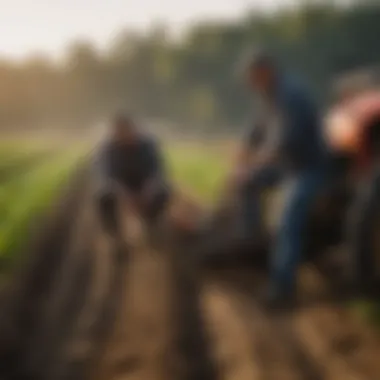
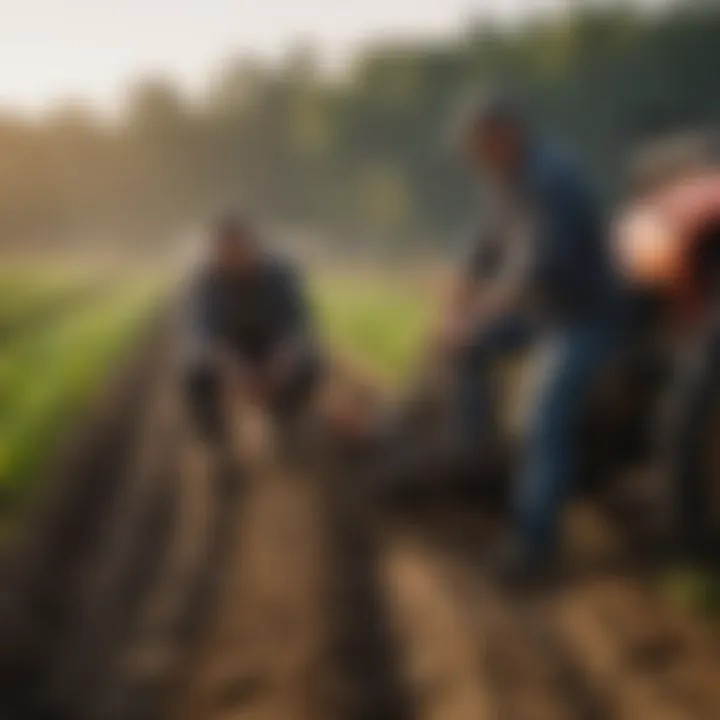
In summary, assessing your needs alongside conducting a comparative model analysis are essential steps in selecting the right Countyline rototiller. By understanding what you require and thoroughly examining the available options, you set the foundation for successful soil management and crop growth.
Operating a Countyline Rototiller
Operating a Countyline rototiller correctly is essential for maximizing its efficiency and effectiveness in soil preparation. Proper operation not only enhances the tilling process but also extends the lifespan of the equipment. This section will cover critical pre-operational checks and operational techniques that ensure optimal performance.
Pre-Operational Checks
Before starting a Countyline rototiller, a set of pre-operational checks is necessary to ensure safety and functionality. These checks prevent potential damage to the machine and ensure better results in the field.
- Inspect the Fuel System: Verify that there is enough fuel in the tank. Use fresh fuel that meets the manufacturer’s specifications. Check for any leaks or signs of wear in the fuel lines.
- Examine the Blades: Ensure the tines or blades are sharp and in good condition. Dull blades hinder performance and require more power to operate.
- Check the Oil Levels: The engine oil should be at the recommended level. Low oil can lead to engine damage.
- Secure the Bolts and Fasteners: Inspect all bolts and fasteners on the machine. Loose components can affect tilling performance and safety.
- Assess the Tires and Belts: If the model is wheeled, check the tires for proper inflation. Also, examine the belts for fraying or wear.
Performing these checks will provide peace of mind and better productivity when operating the rototiller.
Operational Techniques
Once the pre-operational checks are complete, understanding proper operational techniques is crucial for effective tilling. Each technique contributes to achieving optimal soil preparation.
- Start and Stop Procedures: Always start the rototiller in a clear area to prevent accidents. Follow the manufacturer's guidelines for starting the engine and allow it to warm up before tilling. When stopping, lower the tines to the ground to prevent them from spinning unnecessarily.
- Proper Tilling Depth: Adjust the tilling depth according to what is suitable for the type of crops or soil. Generally, a depth of 4 to 6 inches is recommended for most gardening needs. Be cautious not to go too deep, as it may disrupt soil layers too much.
- Maintain a Steady Pace: Operate the rototiller at a consistent speed. This helps to ensure even soil mixing and reduces the strain on the engine.
- Control Tilling Direction: Begin tilling in a straight line, overlapping each pass slightly. If using a rear-tine model, it is beneficial to move in the same direction as the tiller for easier handling.
- Avoid Obstacles: Look out for rocks, roots, or other debris as you operate. These can damage the blades and pose a safety risk.
By mastering these operational techniques, users can significantly enhance their tilling experience, resulting in better-prepared soil and healthier crops.
"Proper operation of your Countyline rototiller is key to maximizing productivity and ensuring the longevity of your equipment."
Understanding how to effectively operate your Countyline rototiller is a fundamental step in successful gardening or farming. With the right approach, you can reap the benefits of improved soil health and increased crop yields.
Maintenance Best Practices
Maintaining Countyline rototillers is crucial to ensure their durability, efficiency, and performance. The practice of routine maintenance extends the machine's lifespan and enhances its functionality. By prioritizing maintenance best practices, users can avoided unexpected breakdowns during important tasks, which can lead to delays and increased costs. These practices encompass regular inspections, seasonal tasks, and effective troubleshooting methods.
Routine Check-Ups
Routine check-ups are fundamental in identifying potential issues before they escalate. During these inspections, one should evaluate the following components:
- Engine Oil: Checking oil levels and quality is essential. Old or low oil can lead to engine wear.
- Air Filters: Clean or replace air filters to prevent dirt from entering the engine, enhancing performance.
- Tines: Inspect the tiller tines for damage or wear. Dull or broken tines can reduce effectiveness in soil preparation.
- Belts and Cables: Look for any signs of wear or fraying. Replacing these parts before they fail can prevent inconvenient breakdowns.
- Bolts and Nuts: Ensure all fastenings are secure. Vibration during operation can loosen components over time.
Tip: Document each check-up to track what repairs you have done.
Seasonal Maintenance Tasks
Seasonal maintenance tasks play an important role in prepping the rototiller for different usage conditions throughout the year. Consider the following:
- Pre-Spring Check-Up: Before the planting season, perform a thorough inspection, focusing on tines and oil levels. Ensure all parts are clean and operational.
- Post-Season Cleaning: After the heavy usage season, clean the rototiller thoroughly. Remove soil and debris. This helps in preventing rust and other damage.
- Lubrication: Apply lubricant to all moving parts according to the manufacturer’s guidelines. This reduces friction and helps in smooth operations.
- Storage Preparations: When the season ends, ensure the rototiller is stored in a dry location. Cover it to protect against dust and moisture.
Troubleshooting Common Issues
Understanding and troubleshooting common issues can save time and money. Here are some frequent problems and their solutions:
- Engine Won't Start: Check fuel levels, oil quality, and spark plugs. This often indicates an issue with ignition or fuel delivery.
- Uneven Tilling: Inspect the tines to assure they are not damaged or worn. Adjust the depth setting for consistent results.
- Overheating: This can be caused by blocked air filters or low oil. Regularly clean filters and check oil levels to prevent overheating.
"Prevention is better than cure." Regular check-ups and maintenance can prevent most issues before they arise.
Being proactive in maintaining a Countyline rototiller ensures optimal performance and longevity. Following a structured maintenance plan enhances usability and encourages better results in field preparation.
Economic Impact of Countyline Rototillers
Understanding the economic implications of Countyline rototillers is essential for farmers and enthusiasts. These tillers are a significant investment and can affect both short-term costs and long-term gains in productivity. Evaluating their economic impact includes examining ownership costs, operational efficiencies, and potential gains in yield.
For farmers, the ability to cultivate land effectively can lead to increased productivity. Rototillers break up the soil, enhance aeration, and improve drainage. This results in healthier crops, ultimately translating into greater revenue. It is also important to analyze how these machines reduce labor costs, which can be substantial in large-scale operations. By mechanizing the tilling process, farmers can save time and energy, allowing labor to be allocated to other critical farm tasks.
Additionally, the sustainability aspect plays a role in the economic analysis. Utilizing Countyline rototillers for soil preparation can improve soil health over time, decreasing the need for chemical fertilizers and pesticides. This has both cost-saving implications and benefits for the environment. Therefore, understanding the full financial picture is crucial for making informed decisions regarding tillage practices.
Cost-Benefit Analysis
Performing a cost-benefit analysis for Countyline rototillers helps outline their financial viability. To delve deeper into this analysis:
- Initial Investment: The purchase price of a Countyline rototiller represents the upfront cost. Model variety leads to different price points, so careful selection is key.
- Operational Costs: Factors include fuel or electricity, maintenance, and repairs over time.
- Labor Savings: The time saved through mechanization should be quantified.
- Yield Increases: Estimate potential crop yield improvements from more effective soil management.
"Understanding the economic viability of using Countyline rototillers should bring together initial costs and long-term benefits."
Factors to Consider in Cost-Benefit
- Long-term Usage: How often will the rototiller be used? Frequent usage can offset the initial investment more effectively.
- Resale Value: Consider the depreciation and future resale market.
- Financing Options: Analyze if leasing or purchasing outright is more cost-effective.
By comprehensively analyzing both quantifiable and qualitative aspects, farmers can make evidence-based decisions that align with their operational goals.
Environmental Considerations
The environmental impact of farming practices is a significant concern for modern agriculture. Countyline rototillers, while effective in soil preparation, can also be aligned with sustainable farming practices. This section discusses key aspects related to environmental considerations, specifically how these machines affect soil health and sustainability, as well as their carbon footprint.
Soil Health and Sustainability
Soil health is essential for productive farming. Countyline rototillers play an important role in enhancing this health by improving soil structure and increasing its aeration. Proper tilting leads to better water infiltration, reducing erosion and runoff. Improved aeration encourages microbial activity, promoting nutrient cycling essential for crop growth.
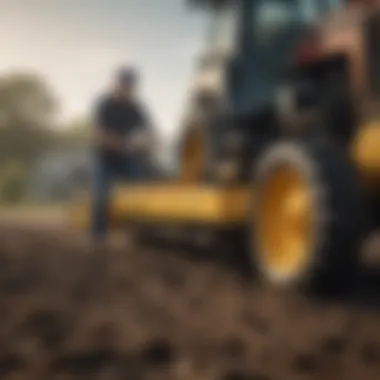
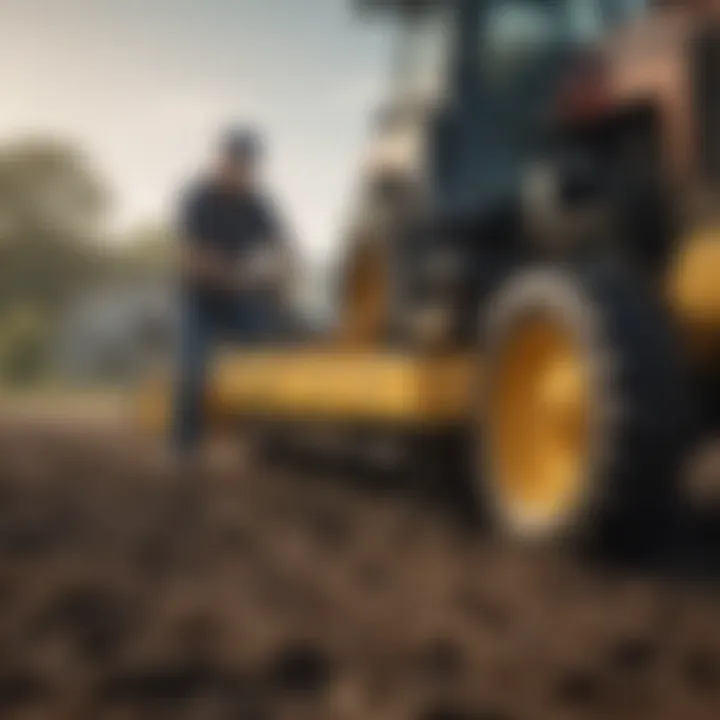
However, excessive tilling can lead to soil degradation. It is important for farmers to strike a balance, using Countyline rototillers judiciously and adopting techniques like no-till farming where applicable. Here are some practices that promote soil health and sustainability while using rototillers:
- Practice Crop Rotation: This improves soil fertility and prevents pest build-up.
- Adopt Cover Cropping: It protects soil during off-seasons and enhances organic matter.
- Limit Tilling Depth: Shallow tilling minimizes disturbance to soil ecosystems.
These practices ensure that Countyline rototillers enhance not only productivity but also sustain the soil environment.
Impact on Carbon Footprint
The carbon footprint of agricultural practices is a pressing concern as it relates to climate change. The operation of Countyline rototillers, especially gas-powered models, contributes to greenhouse gas emissions. However, their proper use can also help mitigate these impacts.
For example, by using rototillers to prepare land more effectively, farmers can achieve better yields with fewer inputs. This efficiency reduces the overall fossil fuel consumption associated with planting and maintenance.
Here are some strategies to minimize the carbon footprint while using Countyline rototillers:
- Choose Electric Models: They produce no direct emissions during operation.
- Use as Part of a Holistic Management Plan: Integrating tilling with other practices to optimize land use can enhance efficiency.
- Implement Locally-based Farming Techniques: Adjusting methods based on local conditions can reduce travel distances and machine usage.
Minimizing carbon footprint while maximizing productivity is essential for sustainable agriculture. Thoughtful practices in using Countyline rototillers contribute to a healthier planet.
User Experiences and Testimonials
In discussing Countyline rototillers, user experiences and testimonials are critical. They offer authentic insights into the real-world performance of these machines. When farmers and gardening enthusiasts share their stories, they provide potential buyers with useful information that goes beyond technical specifications. Individual feedback can reveal the strengths and weaknesses of different models, contributing to better-informed purchasing decisions.
These testimonials often highlight specific features appreciated by users, such as the reliability of the engine, efficiency in soil preparation, and ease of operation. For instance, detailed accounts from frequent users may uncover how a particular rototiller performs under various soil conditions, which is essential knowledge for anyone involved in agriculture or horticulture.
Moreover, understanding user experiences can underscore the importance of maintenance practices. Users often discuss how regular upkeep impacted their machine's lifespan and performance, allowing new owners to adopt best practices from the outset.
Benefits of User Experiences
- Real-Life Applications: They depict how the rototillers function in diverse environments, helping readers visualize their effectiveness.
- Feature Insights: Potential buyers can learn which features are truly beneficial and which may be superfluous.
- Long-Term Use: Testimonials from long-term users highlight durability and reliability, aspects that are often not apparent in promotional content.
User experiences fuse technical information with practical context, enriching the conversation around Countyline rototillers.
Considerations About User Testimonials
While user testimonials are invaluable, readers should consider a few things. Individual experiences may vary based on local soil types, climates, and usage frequency. Therefore, it is recommended to look for patterns among multiple testimonials to gain a comprehensive view of a product’s performance.
In summary, testimonials provide a nuanced perspective on Countyline rototillers. They enhance understanding, particularly for farmers and gardening enthusiasts, by presenting relatable, real-world accounts of product effectiveness and user satisfaction.
"The performance of my Countyline rototiller transformed my gardening experience. I can manage my soil preparation tasks much faster now, and the ease of use is remarkable."
Case Studies from Farmers
Case studies from farmers offer a powerful way to understand the practical impacts of Countyline rototillers. These studies often draw attention to unique agricultural challenges and how specific models have effectively addressed these problems.
One farmer might share a detailed account of using a Countyline rear tine rototiller for preparing ground that had not been worked in years. This narrative could highlight the tiller’s ability to break up compacted soil, enhancing aeration and nutrient access for future crops. Farmers appreciate this firsthand knowledge since it deals directly with the realities they face in their fields.
Additionally, case studies can demonstrate the economic benefits of using Countyline rototillers. A farmer may report on how their investment in a gas-powered model led to increased yield and reduced labor hours. This information can be vital for others making similar decisions, especially concerning return on investment.
Furthermore, these stories can also reflect the trends in farming methods. A case study might reveal how a farmer transitioned to sustainable practices, where Countyline rototillers played a role in improving soil health while minimizing chemical inputs.
Overall, case studies serve as a bridge between theoretical knowledge and practical application. They illustrate the value of Countyline rototillers in various agricultural settings, guiding potential users to make informed decisions. Whether addressing an innovative approach to traditional farming or emphasizing the importance of mechanic maintenance, these narratives enhance the credibility and relevance of the article.
Future Trends in Rototilling
The area of rototilling is continuously evolving. This is essential for understanding how machinery like Countyline rototillers can improve agricultural productivity. Identifying future trends in this field reveals how technology can potentially reshape farming practices. As farmers face challenges from climate change and increasing market demands, innovation becomes necessary for sustainable growth.
Advancements in Technology
Advancements in technology are rapidly changing the landscape of rototilling. Contemporary rototillers integrate enhanced engineering designs that lead to improved efficiency. Features such as electric power systems are gaining traction. These models offer quieter operation and reduced carbon emissions. Moreover, smart technology is becoming prevalent. IoT sensors can provide real-time data on soil conditions. This empowers farmers to tailor their tilling practices to specific needs.
Furthermore, GPS-enabled tillers allow for precision tilling. With accurate monitoring, farmers can avoid overlapping and save on fuel costs. This not only increases productivity but also promotes environmental conservation.
The Role of Robotics and Automation
The role of robotics in agriculture is another trend that is reshaping rototilling. Robotic tillers can operate autonomously, reducing the need for manual labor. This shift improves efficiency and alleviates labor shortages that many farmers face today.
Automation also allows for higher precision in tilling. Robotic systems can adjust to varying soil conditions, ensuring optimal tillage for every part of the field. This targeted approach can enhance soil health and crop yield.
"Automation and robotics are essential for modern agriculture, allowing us to increase yields while maintaining sustainability."
The integration of these technologies in Countyline rototillers is noteworthy. As these tools evolve, access to soil data and enhanced operational control will drive future best practices in farming. Adoption of robotics and advanced technology will likely be a determinant factor in the success of farms in the future.
Finale and Final Thoughts
In summarizing the insights from this article, we acknowledge that Countyline rototillers hold a significant place in modern agriculture. They are not merely tools but a crucial element in enhancing soil health and optimizing crop yield. Our exploration has illustrated various types, their key features, and the myriad of benefits they offer, ranging from efficient soil aeration to effective pest control. The analysis not only emphasizes the utility of these machines but also connects their operation to the wider context of sustainable farming practices.
The importance of Countyline rototillers is further underscored by their impact on the economic viability of farming. Farmers can achieve better output and high-quality soil readiness. This guides decisions on tool selection and maintenance, ultimately translating into higher profit margins.
Additionally, in the face of increasing environmental challenges, these machines advocate for practices that bolster sustainability. The thoughtful operation, maintenance, and selection of Countyline rototillers can significantly contribute to efficient farming while preserving natural ecosystems.
Recap of Key Points
- Types of Countyline Rototillers: Different models such as rear-tine and front-tine serve various agricultural needs.
- Key Features: Understanding engine specifications and tilling capacities are vital for optimal selection.
- Advantages: These rototillers enhance soil aeration and seed bed preparation, leading to improved crop outcomes.
- Maintenance: Regular checks and seasonal upkeep ensure longevity and reliability of the equipment.
- Environmental Impact: Usage aligns with sustainable practices, minimizing disruption to the soil ecosystem.
Encouragement for Sustainable Practices
Farmers and enthusiasts alike are urged to adopt sustainable practices with Countyline rototillers. This involves not only the efficient use of these machines but also considering the long-term impacts of tilling on soil health. Techniques such as reducing tillage frequency, optimizing tilling depth, and timing can significantly enhance soil structure and biodiversity.
Encouragement comes from the recognition that sustainable practices yield benefits in productivity and environmental integrity. Sustainable farming methods not only protect the immediate land but also contribute to broader ecological stability. It is essential to remain informed about advancements in rototilling technology and incorporate them effectively. As we all strive for a better agricultural future, adopting a sustainable mindset is the key.
Embracing these principles leads to improved soil health, ultimately translating into better yield and reduced dependency on chemical inputs.



